"Marder", "Hetzer" and other German and Romanian self-propelled artillery installations based on tanks Pz.Kpfw.35 (t) and Pz.Kpfw.38 (t)
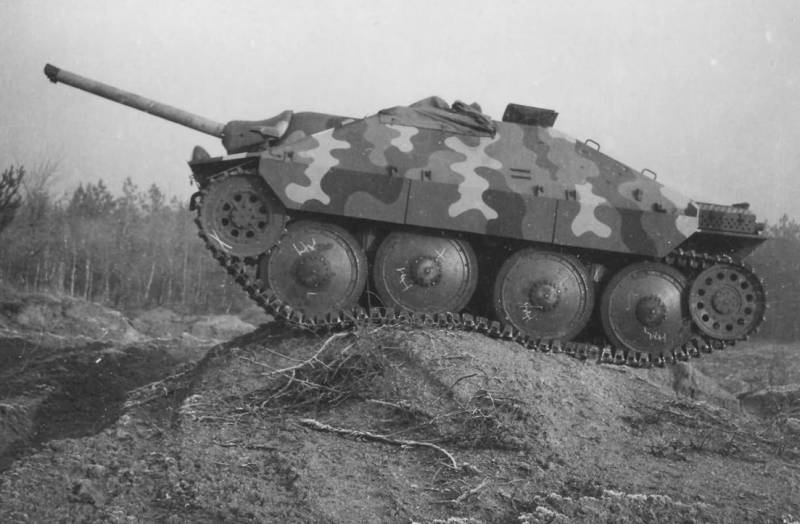
At the initial stage of World War II, the lungs Tanks Czech-made Pz. Kpfw. 35(t) and Pz. Kpfw. 38 (t) made up a significant proportion of the tank fleet of Nazi Germany. However, taking into account the fact that the Pz. Kpfw. 35 (t) and early versions of the Pz. Kpfw. 38 (t) frontal armor thickness did not exceed 25 mm, these armored vehicles were easily hit not only by all Soviet anti-tank guns, but also by 14,5 mm armor-piercing rifles.
Increased frontal armor Pz. Kpfw. 38 (t) of later modifications to 50 mm slightly increased security, but the cramped turret did not allow mounting a gun with a caliber of more than 37 mm on Czech tanks, which significantly limited the possibilities for firing a fragmentation projectile at manpower, did not allow to effectively destroy field fortifications and counteract Soviet T-34 and KV. By the end of 1942, the Pz. Kpfw. 35(t) and Pz. Kpfw. 38 (t) remained in the training units and were used to fight the partisans. Some of the surviving tanks were converted into armored ammunition transporters and artillery tractors or transferred to the allies.
The German administration was aware that the transition of the industry of the Protectorate of Bohemia and Moravia to the production of German-style tanks would require significant investment and adversely affect the rate of production, which was highly undesirable in wartime. In this regard, the successful chassis of the Pz. Kpfw. 38 (t) was used to produce several types of self-propelled artillery mounts, armored flamethrower and recovery vehicles, as well as ammunition transporters.
Romanian self-propelled artillery TACAM R-2 based on the Pz. Kpfw. 35(t)
The German command understood that the light tanks Pz. Kpfw. 35(t) are largely obsolete. However, due to the lack of armored vehicles, these vehicles participated in the attack on Poland, in the battles in France and in Operation Barbarossa.
In the spring of 1942 Pz. Kpfw. 35 (t) due to large losses actually ceased to be used in parts of the first line. Almost all the tanks that survived by the end of 1942 were converted into armored tractors or transferred to Romania.
Taking into account the saturation of the combat formations of the Red Army with medium and heavy tanks with anti-ballistic armor and a radical strengthening of the Soviet anti-tank defense, the Romanian R-2 (licensed version of the LT vz. 35) and the Pz transferred by the Germans. Kpfw. 35 (t) had no prospects when applied in its original form. In this regard, it was decided to convert 40 tanks R-2 and LT vz. 35 into anti-tank self-propelled artillery mounts, arming them with captured Soviet 76,2-mm ZiS-3 guns. However, these plans could not be fully implemented; taking into account the prototype, 21 self-propelled guns were built.
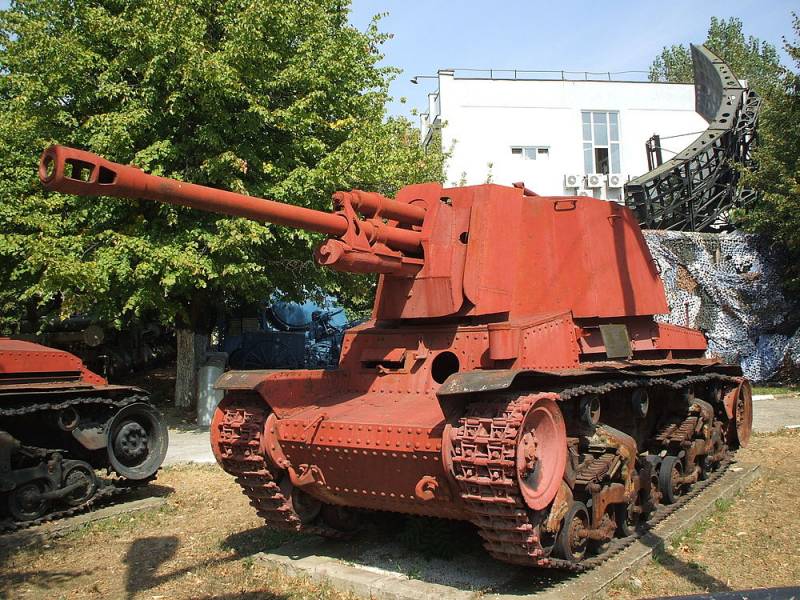
The creation of tank destroyers was entrusted to the company Leonida. The installation received the designation TACAM R-2 (rum. Tun Anticar pe Afet Mobil R-2 - self-propelled anti-tank gun on the chassis of the R-2 tank).
The 76,2-mm gun was installed in a trihedral armored cabin open from above, covering the gun itself and the crew. According to Romanian sources, the gunhouses of the TACAM R-2 self-propelled guns were assembled from armor sheets cut from Soviet T-26 and BT-7 tanks. The 76-mm gun could be aimed in a horizontal sector of 30°, vertical aiming angles: from -5° to +25°. The ammunition load was 30 rounds. The 7,92 mm machine gun TK vz. 37 (ZB-53), which made it possible to fight infantry. Crew - 4 people.
Compared to the base vehicle, the TACAM R-2 self-propelled guns became heavier by about 1 ton, and its weight in combat position approached 12 tons. The increase in weight led to a decrease in mobility and power reserve. The maximum speed on the highway did not exceed 30 km / h, and refueling tanks were enough for 160 km.
In terms of combat characteristics, the TACAM R-2 installation approximately corresponded to the SU-76M self-propelled guns and, with proper use, could successfully fight the T-34. The Soviet 76,2-mm blunt-headed armor-piercing projectile 53-BR-350A with an initial speed of 662 m / s at a distance of 500 m normally pierced 70-mm armor.
The first batch of 10 self-propelled guns was sent to the front in July 1944. After Romania sided with the USSR, TACAM R-2 installations participated in battles with the Germans. Self-propelled guns fought in Northern Transylvania and Czechoslovakia. Several cars were lost. One self-propelled gun TACAM R-2 has survived to this day, now it is on display at the Romanian National Military Museum in Bucharest.
Self-propelled artillery mounts of the Marder III family
From the first days of the campaign in the East, German troops faced breakthroughs from Soviet tanks. Often, anti-tank units equipped with towed guns did not have time to turn around in the right place or change their position. In a much more advantageous position were self-propelled units on a tank chassis, capable of moving over rough terrain and soft soils. Anti-tank self-propelled guns could fire without preliminary deployment, quickly get out of the shelling, maneuver and take an advantageous position. In addition, unlike towed guns, self-propelled guns could accompany tanks in the attack, supporting them with fire throughout the battle.
As a basis for the creation of self-propelled tank destroyers, various light tank chassis were used, including Pz. Kpfw. 38(t). In addition to Soviet 76,2 mm guns, German 75 mm PaK anti-tank guns were also mounted on the Czech chassis. 40. Self-propelled artillery mounts with 75-76,2 mm guns based on Pz. Kpfw. 38 (t) received the designation Marder III (German marder - marten).
The first tank destroyer 7,62 cm PaK (r) auf Pz. 38 (t) Marder III (Sd. Kfz. 139) left the assembly shop of the Boehmisch-Mahrish-Maschinenfabrik in Prague (former Czech CzKD) on April 10, 1942.
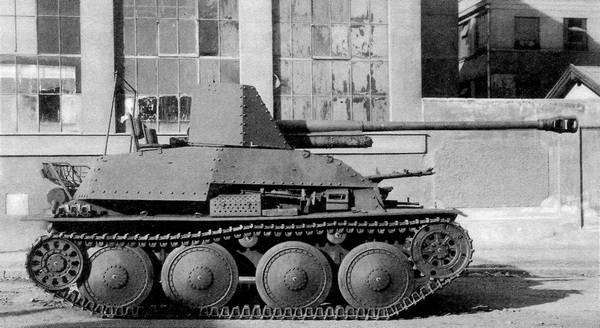
Tank destroyer Sd. Kfz. 139 Marder III
The self-propelled gun was armed with a modernized captured Soviet 76,2-mm F-22 divisional gun, which received the designation PaK 36 (r) after completion. For self-defense against infantry, there was a 7,92 mm MG machine gun. 37(t).
In the summer and autumn of 1941, the Wehrmacht captured approximately 1 Soviet F-300 guns. The Germans used some of them in a towed version, and some - for arming self-propelled artillery installations. Initially, captured guns were used in their original form under the designation 22 cm FK 7,62 (r). But at the end of 296, German engineers, having studied the gun, found out that it had a large margin of safety, after which a project was developed to upgrade the F-1941 into an anti-tank gun 22 cm PaK 7,62 (r).
Changes were made to the design of the artillery system regarding the guidance and recoil mechanisms. The regular shield was replaced with a two-layer and low-profile one. But most importantly, German specialists developed a new shot with a bottle-shaped sleeve for the captured cannon, which made it possible to increase the propellant charge by 2,4 times. For a new shot, the chamber had to be squandered, and to reduce the recoil force, a muzzle brake was installed. In fact, German engineers returned to what V. G. Grabin proposed in 1935.
It is worth recognizing that the massive conversion of the F-22 into 7,62 cm Pak. 36 (r) justified itself, since the cost of the conversion was an order of magnitude cheaper than the cost of a new gun. Production of PaK 36(r) anti-tank guns began in 1942 and was completed at the end of 1943.
Due to the increase in muzzle energy, it was possible to significantly increase armor penetration. German 76,2 mm armor-piercing tracer with a ballistic tip 7,62 cm Pzgr. 39 weighing 7,6 kg had an initial speed of 740 m / s and at a range of 500 m normal could penetrate 108-mm armor.
In smaller quantities, shots were fired with a 7,62 cm Pzgr. 40. At an initial speed of 990 m / s, a projectile weighing 3,9 kg at a distance of 500 m at a right angle pierced 140 mm armor. The ammunition could also include 7,62 cm Gr. 38 Hl/B and 7,62 cm Gr. 38 Hl/C with a mass of 4,62 kg and 5,05 kg, which (regardless of range) provided normal penetration of 90–100 mm armor.
For the sake of completeness, it is appropriate to compare the 7,62 cm Pak. 36 (r) with a 75 mm anti-tank gun 7,5 cm Pak. 40, which, in terms of cost, a set of service, operational and combat characteristics, can be considered the best of those mass-produced in Germany during the war years. At a range of 500 m, a 75-mm armor-piercing projectile could normally penetrate 118-mm armor. Under the same conditions, the armor penetration of a sub-caliber projectile was 146 mm.
Thus, it can be stated that the guns had practically equal characteristics in terms of armor penetration and confidently ensured the defeat of medium tanks at real firing distances.
Self-propelled gun 7,62 cm Pak. 36 (r) was mounted on a carriage, mounted in a fixed, low-profile, riveted, open top and rear wheelhouse. The gun itself was covered by a U-shaped shield 14,5 mm thick, which protected from bullets and shrapnel. The frontal part of the ACS hull and the front of the cabin had a thickness of 50 mm, the sides and rear of the hull - 15 mm, the cabin side - 16 mm. The gun had horizontal firing angles of 21° to the left and right of the longitudinal axis of the tank. Vertical pointing angles ranged from -6° to +18°. Auxiliary armament of the self-propelled guns consisted of a machine gun MG 37 (t).
A machine with a combat weight of 10,7 tons was equipped with a 140 hp carburetor engine. With. and could move along the highway at a speed of 38 km / h. Cruising on the highway - 185 km. Crew - 4 people.
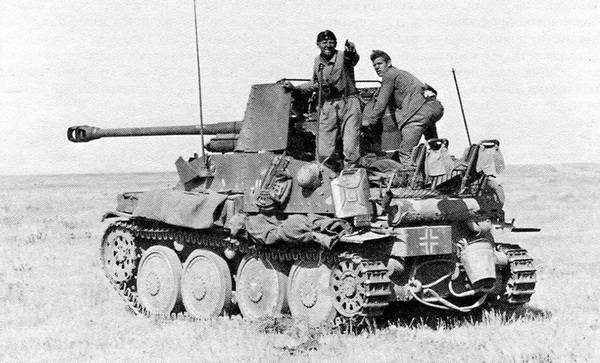
Tank destroyer Sd. Kfz. 139 Marder III in the vicinity of Stalingrad. Eastern Front, August 1942
Serial production of tank destroyers Sd. Kfz. 139 Marder IIIs armed with the 7,62 cm Pak. 36(r), continued until November 1942. In total, 344 new self-propelled guns were built, another 19 self-propelled guns of this type were converted from linear light tanks Pz. Kpfw. 38 (t), requiring refurbishment.
From November 1942 on the Pz. Kpfw. 38 (t) instead of 7,62 cm Pak. 36 began installing the 7,5 cm Pak anti-tank gun. 40/3. This modification is known as Sd. Kfz. 138 Ausf. H Marder III (Marder III Ausf. H).
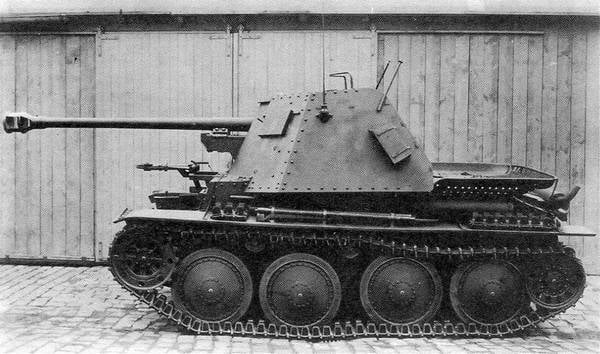
Tank destroyer Sd. Kfz. 138 Ausf. H Marder III
As in the previous modification, a fixed open-type cabin was installed in the middle of the hull. The chassis and hull of the base tank remained unchanged. The visual differences between the models with 76,2 mm and 75 mm guns were in the design of the cabin and in the external differences between the guns. Combat weight increased by 100 kg. The security and mobility of the machine has not changed much. For firing at air targets, an MG machine gun could be mounted on a bracket on one of the sides of the cabin or on an arc above the fighting compartment. 34. Ammunition included 38 rounds for the cannon and 600 rounds for machine guns.
Serial production of tank destroyers Marder III Ausf. H lasted from November 1942 to October 1943. During this period, 243 self-propelled guns were produced, another 338 self-propelled guns of this type were converted from linear light tanks.
In May 1943, the Sd. Kfz. 138 Ausf. M Marder III (Marder III Ausf. M) with a fixed open-type cabin located in the aft part of the hull. On this modification, the body of the self-propelled gun was completely redesigned. The number of parts and riveted joints was reduced, welding was widely used. The car became lower, and the thickness of the armor was almost halved. In front of the self-propelled gun, only the driver's seat was preserved, covered with a cast turret with a viewing device and a double-leaf landing hatch. The combat and engine compartments were swapped. Praga AC six-cylinder liquid-cooled carburetor engine with a capacity of 150 hp. With. moved forward, into the middle part of the body, while eliminating the cardan shaft.
Armor plates with a thickness of 6 to 15 mm were assembled on a frame from corners using bolts with bulletproof heads. The aft wall of the felling was hinged. The installation of the gun provided horizontal guidance angles up to 21 ° left and right. Vertical pointing angles ranged from -5° to +13°. The rate of fire of the gun reached 14 rds / min. The crew had a machine gun MG. 34 or MG. 42, which was mounted on a bracket on one of the sides of the cabin or on an arc above the fighting compartment.
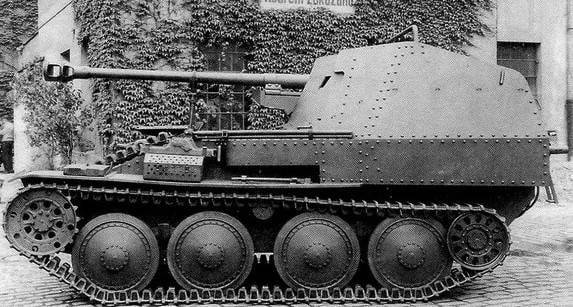
Tank destroyer Sd. Kfz. 138 Ausf. M Marder III
By reducing the thickness of the frontal armor plates from 50 to 10–15 mm, it was possible to reduce the cost of production, and the combat weight was reduced by 300 kg. Thanks to the use of a more powerful engine and a reduction in weight, it was possible to improve the mobility of the machine. The maximum speed on the highway is up to 45 km / h. Cruising on the highway - 190 km. Crew - 3 people.
Self-propelled installation Marder III Ausf. M turned out to be the least protected modification, but the most mobile, fast and passable, as well as the least noticeable, which made it well suited for ambush operations. In general, despite the design differences, the Marder III Ausf. H and Marder III Ausf. M had almost the same indicators of combat effectiveness.
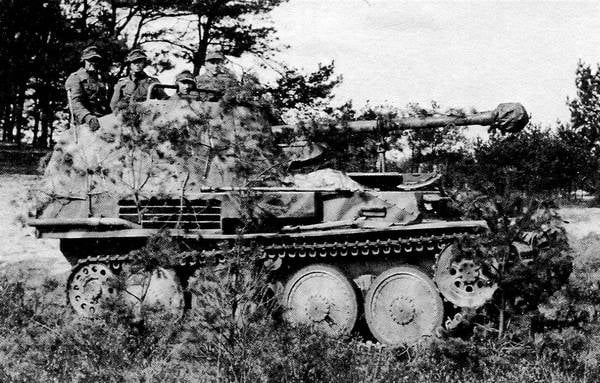
Tank destroyer Marder III Ausf. M. Eastern Front, Poland, summer 1944
Until May 1944, 975 Marder III Ausf self-propelled tank destroyers were built. M. In total, until June 1944, the VMM enterprise handed over to the customer 1 self-propelled artillery installations of the Marder III family, which fought until the last days of the war.
Grille 150mm self-propelled artillery mount
In March 1942, representatives of the VMM plant proposed, in addition to tank destroyers, to develop a number of other installations based on the Pz. Kpfw. 38 (t), including self-propelled guns armed with a heavy field gun 15 cm sIG 33 (German 15 cm schweres Infanterie Geschütz 33).
Towed 150 mm guns 15 cm sIG. 33 were attached to infantry regiments. According to the states of 1940, a regimental artillery battery was supposed to have 6 light guns 7,5 cm le. IG. 18 and two heavy guns 15 cm sIG. 33.
The 150 mm infantry gun had very good performance. The maximum elevation angle was 73º - that is, the gun was a full-fledged howitzer. The range of horizontal aiming angles, despite a simple single-bar carriage, was also quite large - 11,5º to the right and left. Weight in the variant for mechanical traction - 1 kg.
For firing, shots with separate-sleeve loading were used. Rate of fire - up to 4 rds / min. High-explosive fragmentation grenades 15 cm IGr. 33 and 15 cm IGr. 38 weighing 38 kg contained 7,8–8,3 kg of TNT or amatol. When the fuse was set to instant action, lethal fragments flew 20 m forward, 40-45 m to the side and 5 meters back. The high-explosive action of the shells was more than enough to destroy light field fortifications. The shells overcame shelters up to three meters thick made of earth and logs. At the end of 1941, cumulative 15 cm IGr shells began to enter the troops. 39 HL/A with normal armor penetration of 160 mm. With a mass of 24,6 kg, the projectile was loaded with 4,14 kg of hexogen. The tabular firing range of such a projectile was 1 m, the effective range was no more than 800 m.
The experience of combat use has demonstrated the high combat effectiveness of 150-mm infantry guns. At the same time, the relatively large weight made it difficult to roll on the battlefield by calculation forces. A completely logical solution to increase mobility was the creation of a self-propelled version.
When creating the self-propelled guns, which received the designation 15 cm sIG 33 (Sfl.) auf Pz. Kpfw. 38(t) Ausf. H (also known as Sd. Kfz. 138/1 Grille), the same work was done as in the development of the Marder III tank destroyer, but the fighting compartment of the vehicle was also increased in proportion to the new gun. The frontal part with a ball machine gun mount for a radio operator and a viewing device for a driver was redone. Instead of a 50-mm frontal armor plate, a sheet of rolled armor 15 mm thick was installed. The thickness of the sides of the hull and deckhouse was 10–15 mm. In the aft part of the cabin open on top there was a double-leaf armored door.
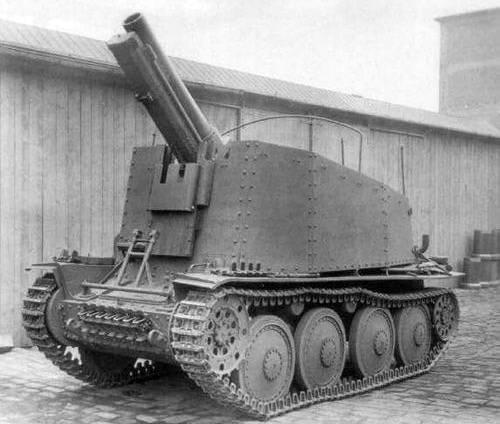
ACS Sd. Kfz. 138/1 aust H Grille
The mass of the self-propelled guns in combat position was 11,5 tons. The carburetor engine with a capacity of 100 liters. With. could accelerate the car on the highway to 42 km / h. Power reserve - up to 185 km. Crew - 4 people. Ammunition - 20 shots.
The downside of high firepower was low stability when firing. The light chassis was not well suited for such a heavy artillery system with high recoil. When firing at low elevation angles, the self-propelled guns jumped back after each shot.
According to the staffing table for tank and panzergrenadier divisions, adopted in 1943, each formation was to have 12 150-mm self-propelled guns, which were attached directly to panzergrenadier regiments as fire support vehicles. Mechanized regiments on armored personnel carriers and motorized regiments on trucks were supposed to have six 150-mm self-propelled guns. However, due to the shortage of self-propelled howitzers, staffing was often not respected.
Due to the relatively small amount of ammunition carried, a battery of three self-propelled guns was attached to an ammunition transporter, which had a similar undercarriage and a wheelhouse without a gun. If necessary, the conveyor could be converted into self-propelled guns.
According to reference data, the Prague company Boehmisch-Mahrish-Maschinenfabrik produced 390 self-propelled guns and 102 transporters. The latest self-propelled guns of improved modification 15 cm sIG 33/2 (Sfl.) Ausf. M were handed over to the customer in March 1945. As of March 1945, the troops had 173 Grille self-propelled guns. For the first time, "Grille" were involved in the battles on the Kursk Bulge in the summer of 1943.
Anti-tank self-propelled artillery mount Hetzer
The Hetzer tank destroyer is the most famous self-propelled gun based on the Czech light tank Pz. Kpfw. 38(t). After Germany switched to strategic defense in the second half of 1943, the shortage of mobile anti-tank weapons became even more acute.
By that time, it became clear to the Wehrmacht command that the Marder III light anti-tank self-propelled guns no longer fully corresponded to the tasks assigned to them. These tank destroyers, which had powerful weapons, were covered only by bulletproof armor. The cabin, open from above and behind, did not protect the calculation from mortar mines and fragmentation grenades. The Eastern Front was grinding self-propelled guns built on the Pz. Kpfw. III and Pz. Kpfw. IV, faster than they had time to produce, and at the beginning of 1944 the question arose of creating a new adequately protected tank destroyer capable of operating in the same battle formations as medium tanks.
The new tank destroyer was supposed to be as simple as possible, cheap, suitable for production in large quantities, mobile and effective on the battlefield. Since the German tank-building enterprises, due to bombing and lack of resources, were chronically unable to produce the required amount of armored vehicles, in order not to reduce the production of German tanks, it was proposed to build a new vehicle on the basis of the outdated light tank Pz. Kpfw. 38(t). The Pz tank was taken as the standard for manufacturability. Kpfw. V. For the same man-hours spent on the production of one "Panther", it was necessary to build three self-propelled guns with equivalent firepower.
The creation of a new tank destroyer would not have been possible without the contribution made by the engineers and workers of the BMM enterprise. The design and assembly of self-propelled guns was carried out at a high pace. The first 3 test vehicles were manufactured in March 1944, and already in April the tank destroyer was put into service under the name Sd. Kfz. 182 Jagdpanzer 38 (t), in the army this car was nicknamed Hetzer (German hetzer - greyhound). Skoda also joined the production of self-propelled guns, which in July 1944 delivered the first 10 vehicles.
Data on production volumes vary greatly, but with a high degree of probability it can be argued that until April 1945, BMM and Skoda managed to build about 3 Jagdpanzer 000 (t) self-propelled guns, which were mainly used in anti-tank battalions of motorized and infantry divisions of the Wehrmacht .
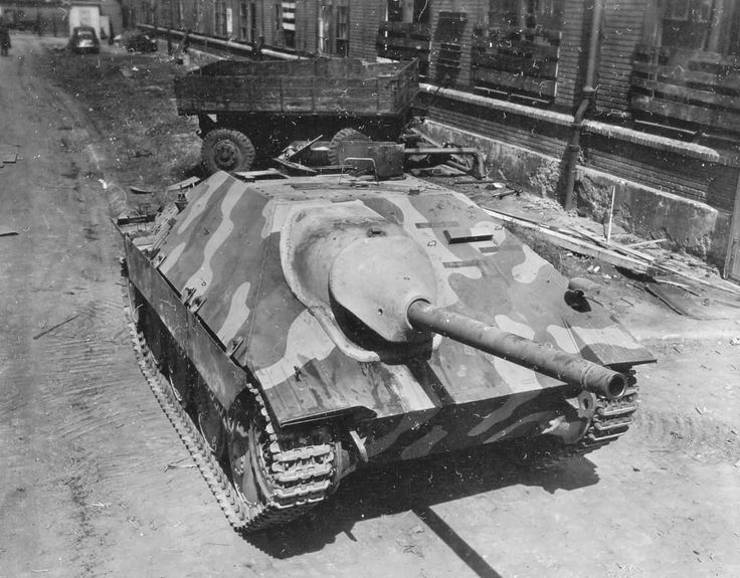
Tank destroyer Sd. Kfz. 182 Jagdpanzer 38(t)
The new anti-tank self-propelled gun had a low hull with rational slopes of the frontal and upper side armor plates, and was armed with a 75-mm cannon with a barrel length of 48 calibers. The gun was protected by a cast armored mask of the "pig's snout" type.
The ammunition load of the guns on the machines of early releases was 41 rounds, from November 1944 it was increased to 46 rounds. A 7,92-mm machine gun was mounted on the roof of the hull, covered with an armored shield. The engine was located at the rear of the car, the drive wheels and transmission were at the front. When creating Hetzer, many fundamentally new solutions were introduced. Although the designers tried to achieve maximum unification with the Marder III light tank destroyer and the Pz. Kpfw 38 (t), the body of relatively thick armor plates was made by welding, not bolts. This technology was used in Czechoslovakia for the first time.
The welded hull, except for the roof of the engine and fighting compartments, was sealed and monolithic. After the development of welding work, the labor intensity of its manufacture in comparison with the riveted method was reduced by almost two times. The nose of the self-propelled gun consisted of armor plates 60 mm thick, which were installed at large angles of inclination - 40 ° lower and 60 ° upper. The sides and feed of the Hetzer had a thickness of 20 mm. The frontal armor withstood the shelling of 45-76,2 mm armor-piercing shells from a distance of more than 300 m. The side armor protected against armor-piercing rifle bullets fired at close range, large fragments and 14,5 mm bullets at a distance of more than 200 m.
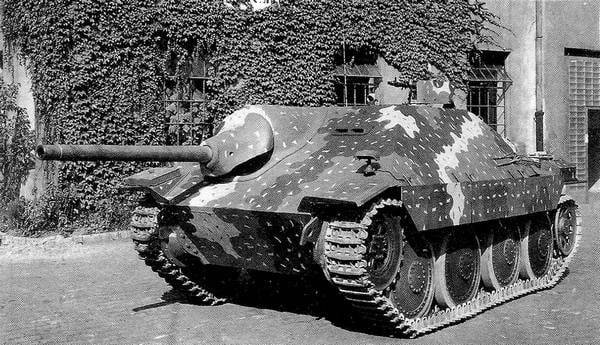
For a vehicle with sufficiently powerful weapons and good armor protection of the frontal projection, the Hetzer had a relatively small weight - 16 tons. With. provided speeds up to 6 km / h. Cruising on the highway - 160 km. Crew - 40 people. For external communications, linear self-propelled guns were equipped with FuG 180 VHF radios. Command vehicles had additional FuG 4 radios.
The small dimensions of the Hetzer reduced its vulnerability in combat and facilitated camouflage. At the same time, the working conditions of the crew inside the ACS were very cramped. The gun had small aiming angles in the horizontal plane (16°), which required a very coordinated work of the gunner and the driver. A lot of criticism caused an unsatisfactory review. The overloaded chassis often broke down when driving over rough terrain.
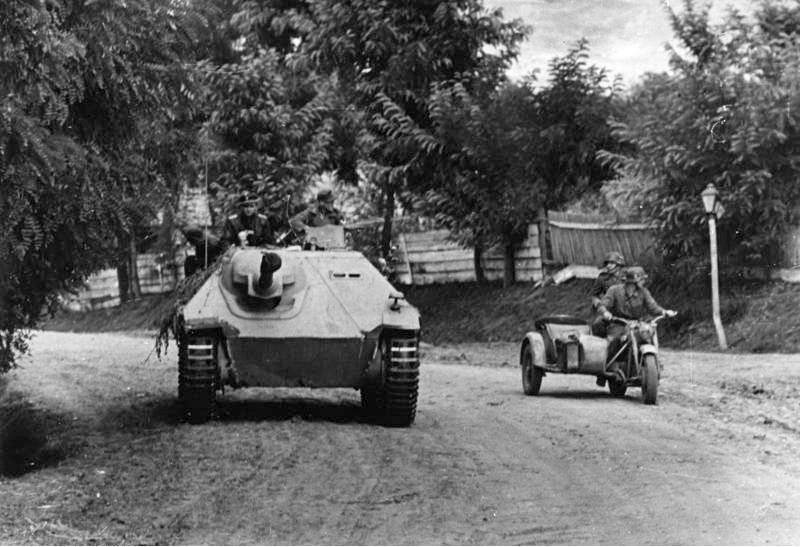
But even taking into account all these shortcomings, the self-propelled gun was considered successful and was actively used on the Eastern and Western fronts. As of April 10, 1945, there were 915 Hetzers in combat units.
In addition to tank destroyers, about fifty Flammpanzer 38 (t) armored flamethrower vehicles were built on the same base, on which the 75-mm gun was replaced with a Flammenwerfer 41 pneumatic flamethrower with a tank with a flamethrower mixture with a capacity of 700 liters placed in the fighting compartment. The range of the flamethrower was 50–60 meters, and the maximum duration of operation was 87 s.
For the evacuation of faulty and padded armored vehicles, the Bergepanzer 38 armored recovery vehicle, built in the amount of 170 units, was intended.
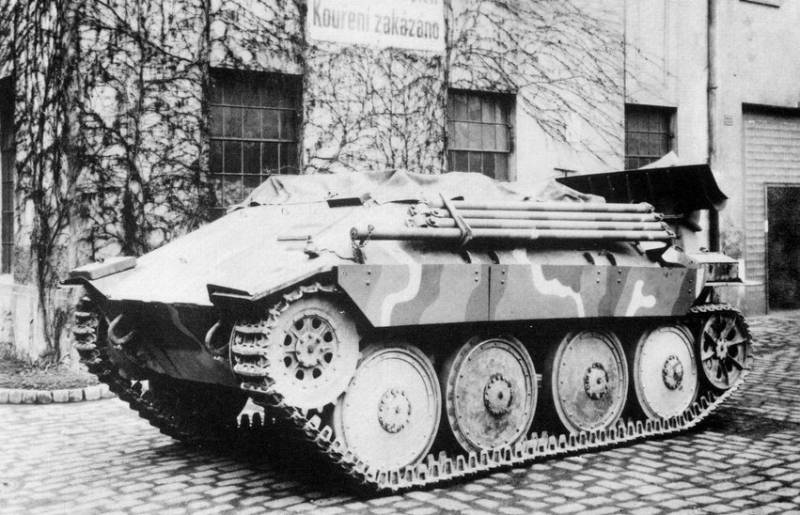
ARV Bergepanzer 38
Compared to the base vehicle, the BREM had a reduced-height cabin without an embrasure in the frontal armor plate and with an open top fighting compartment that closed with an awning, and its armament was limited to the MG machine gun. 34. From the special equipment there was a two-ton crane and towing devices. Some of the machines were also equipped with a folding opener and a 5-ton winch.
At the end of the war, an attempt was made to put into mass production the 150 mm 15 cm sIG 33/2 (Sf) self-propelled gun. The Bergepanzer 38 BREM was used as the base for the self-propelled guns, from which the self-propelled gun differed by the 150-mm sIG 33 cannon installed in the cabin, which had vertical guidance angles from 0 to + 73 °, horizontal: ± 5 °. The frontal part and sides of the cabin were assembled from 10–15 mm armor plates. Carried ammunition was limited to 15 shots. A number of sources claim that they managed to build three dozen such self-propelled guns.
Anti-tank self-propelled artillery installation Waffentrager
Another self-propelled unit built using the Pz. Kpfw. 38 (t) became the Waffentrager 8,8 cm PaK. 43L/71. The terms of reference for the development of this combat vehicle, which in the German classification was called the Waffentrager (weapon carrier), was formulated by the artillery and technical supply department at the end of 1942.
When designing this machine, it was supposed to create an inexpensive single universal platform for 88-127-mm anti-tank guns and 150-mm howitzers. However, due to the overload of design bureaus and factories with other orders, only the project of a tank destroyer armed with an 88-mm PaK anti-tank gun was brought to the stage of practical implementation. 43. In February 1944, the final version on the chassis of the Jagdpanzer 38 (t) Hetzer serial self-propelled gun was approved.
The choice of armament was due to the fact that the 8,8 cm Pak. 43 in combat position weighed 4 kg, and its rolling on the battlefield by the calculation forces was almost impossible. For transportation Pak. 400 needed a fairly powerful tractor. The patency of the tractor hitch with a tool on soft soils was unsatisfactory. At the same time, the 43 mm Pak. 88 was very powerful and ensured a confident defeat of all Soviet tanks used in World War II.
Anti-tank gun 8,8 cm PaK. 43 L / 71 was mounted on a pedestal installation and could fire in a circular sector. True, shooting on the move was not allowed. To protect against bullets from light small arms weapons an armor shield with a thickness of 5 mm was installed. The SPG hull was welded and assembled from rolled armor steel sheets 8–20 mm thick.
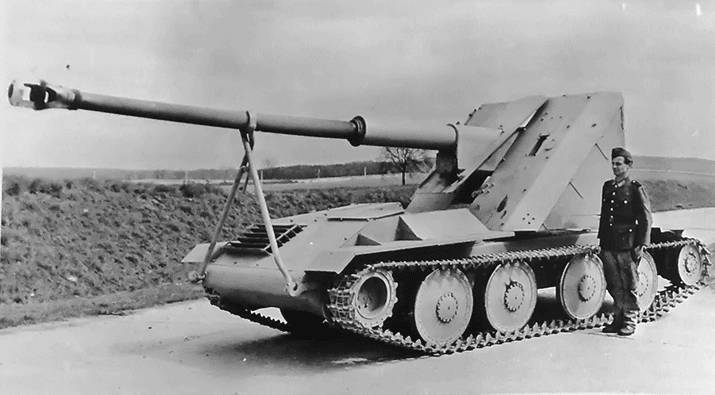
Anti-tank self-propelled artillery mount Waffentrager 8,8 cm PaK. 43L/71
100 hp carburetor engine from. was in the front of the case. The combat weight of the vehicle was 11,2 tons. The maximum speed on the highway was 36 km / h. The power reserve on the highway is 110 km, on the dirt road - 70 km.
In general, a self-propelled mount armed with an 88 mm PaK gun. 43 turned out to be successful. It cost less than other German tank destroyers produced in 1944-1945, and the effectiveness when used from pre-selected positions could be very high. In the event of mass production, the Waffentrager had a chance to become one of the best light self-propelled guns of the final period of the war.
It is now not possible to establish how many Waffentrager anti-tank self-propelled guns were built. Probably, before the cessation of work of the German factories engaged in the production of armored vehicles, it was possible to assemble several dozen self-propelled guns. Two self-propelled guns were captured in May by units of the 3rd Army (1st Belorussian Front) during the storming of Berlin.
Anti-aircraft self-propelled guns
In addition to the tank destroyer Sd. Kfz. 182 Jagdpanzer 38 (t) (Hetzer), on the chassis of the Pz. Kpfw. 38 (t) were created and mass-produced anti-aircraft self-propelled guns, armed with 20-30-mm automatic guns. The prototype ZSU Flakpanzer 38 (t), designed by BMM specialists, entered the test in the summer of 1943.
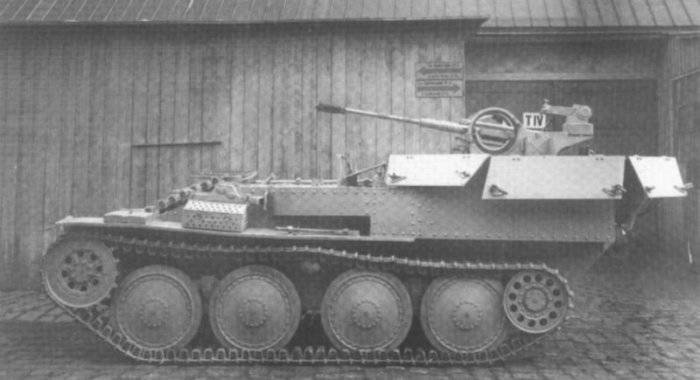
ZSU Flakpanzer 38(t)
The self-propelled anti-aircraft gun had a layout with the location of the transmission compartment in the frontal part of the hull, the control compartment behind it, the engine compartment in the middle part of the hull and the combat compartment in the stern. The fixed cabin, open from above, was located in the aft part of the hull, its walls were assembled from 10-mm armor plates and provided protection from bullets and shrapnel. The upper parts of the cabin walls folded back, which provided a free sector of fire for the 20-mm Flak 38 anti-aircraft automatic gun. The crew consisted of four people.
The anti-aircraft gun was attached to a pedestal mounted on the floor of the fighting compartment. Thanks to this, circular firing and the possibility of vertical aiming in the range from -5 to + 90 ° were ensured. Ammunition for 1 unitary shots was stored in stores of 040 pieces. Flak 20 rate of fire: 38-420 rds/min Firing range at air targets - up to 480 m.
Carburetor engine with a capacity of 150 liters. With. on the highway, he accelerated a tracked vehicle weighing 9 kg in combat position - up to 800 km / h. Power reserve - about 42 km.
ZSU Flakpanzer 38 (t) was produced from November 1943 to February 1944. The customer accepted 141 installations, which were mainly sent to anti-aircraft platoons (4 ZSU) of tank battalions. In March 1945, on several Flakpanzer 38 (t) anti-aircraft tanks, the 20 mm 2,0 cm Flak 38 cannon was replaced by a 30 mm 3,0 cm Flak 103/38.
Externally, an anti-aircraft tank with a 30-mm anti-aircraft gun, created on the basis of the MK air gun. 103, almost did not differ from the ZSU Flakpanzer 38 (t). The 3,0 cm Flak 103/38 anti-aircraft gun was about 2,0 times more effective than the 38 cm Flak 1,5. Since the heavier 30-mm projectile lost its energy more slowly, the maximum slant range of fire against air targets was 5 m, and the altitude reach was 700 m. Due to the use of belt feed and a box for 4 shots, the combat rate of fire increased significantly. The destructive effect of a 700 mm projectile was approximately twice that of a 40 mm projectile.
ZSU with 30-mm guns in May 1945 participated in the battles on the territory of Czechoslovakia and two of them were captured by Soviet troops.
Продолжение следует ...
Information